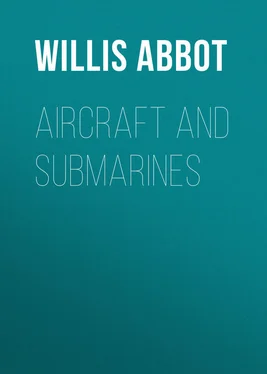Willis Abbot - Aircraft and Submarines
Здесь есть возможность читать онлайн «Willis Abbot - Aircraft and Submarines» — ознакомительный отрывок электронной книги совершенно бесплатно, а после прочтения отрывка купить полную версию. В некоторых случаях можно слушать аудио, скачать через торрент в формате fb2 и присутствует краткое содержание. Жанр: foreign_antique, foreign_prose, на английском языке. Описание произведения, (предисловие) а так же отзывы посетителей доступны на портале библиотеки ЛибКат.
- Название:Aircraft and Submarines
- Автор:
- Жанр:
- Год:неизвестен
- ISBN:нет данных
- Рейтинг книги:4 / 5. Голосов: 1
-
Избранное:Добавить в избранное
- Отзывы:
-
Ваша оценка:
- 80
- 1
- 2
- 3
- 4
- 5
Aircraft and Submarines: краткое содержание, описание и аннотация
Предлагаем к чтению аннотацию, описание, краткое содержание или предисловие (зависит от того, что написал сам автор книги «Aircraft and Submarines»). Если вы не нашли необходимую информацию о книге — напишите в комментариях, мы постараемся отыскать её.
Aircraft and Submarines — читать онлайн ознакомительный отрывок
Ниже представлен текст книги, разбитый по страницам. Система сохранения места последней прочитанной страницы, позволяет с удобством читать онлайн бесплатно книгу «Aircraft and Submarines», без необходимости каждый раз заново искать на чём Вы остановились. Поставьте закладку, и сможете в любой момент перейти на страницу, на которой закончили чтение.
Интервал:
Закладка:
Some think [he wrote of the balloon] Progressive Motion on the Earth may be advanc'd by it, and that a Running Footman or a Horse slung and suspended under such a Globe so as to have no more of Weight pressing the Earth with their Feet than Perhaps 8 or 10 Pounds, might with a fair Wind run in a straight Line across Countries as fast as that Wind, and over Hedges, Ditches and even Waters. It has been even fancied that in time People will keep such Globes anchored in the Air to which by Pullies they may draw up Game to be preserved in the Cool and Water to be frozen when Ice is wanted. And that to get Money it will be contriv'd, by running them up in an Elbow Chair a Mile high for a guinea, etc., etc.
With his New England lineage Franklin could hardly have failed of this comparison: "A few Months since the Idea of Witches riding through the Air upon a broomstick, and that of Philosophers upon a Bag of Smoke would have appeared equally impossible and ridiculous."
To-day when aircraft are the eyes of the armies in the greatest war of history, and when it appears that, with the return of peace, the conquest of the air for the ordinary uses of man will be swiftly completed, Franklin's good-humoured plea for the fullest experimentation is worth recalling. And the touch of piety with which he concludes his argument is a delightful example of the whimsical fashion in which he often undertook to bolster up a mundane theory with a reference to things supernatural.
I am sorry this Experiment is totally neglected in England, where mechanic Genius is so strong. I wish I could see the same Emulation between the two Nations as I see between the two Parties here. Your Philosophy seems to be too bashful. In this Country we are not so much afraid of being laught at. If we do a foolish thing, we are the first to laugh at it ourselves, and are almost as much pleased with a Bon Mot or a Chanson , that ridicules well the Disappointment of a Project, as we might have been with its success. It does not seem to me a good reason to decline prosecuting a new Experiment which apparently increases the power of Man over Matter, till we can see to what Use that Power may be applied. When we have learnt to manage it, we may hope some time or other to find Uses for it, as men have done for Magnetism and Electricity, of which the first Experiments were mere Matters of Amusement.
This Experience is by no means a trifling one. It may be attended with important Consequences that no one can foresee. We should not suffer Pride to prevent our progress in Science.
Beings of a Rank and Nature far superior to ours have not disdained to amuse themselves with making and launching Balloons, otherwise we should never have enjoyed the Light of those glorious objects that rule our Day & Night, nor have had the Pleasure of riding round the Sun ourselves upon the Balloon we now inhabit.
B. Franklin.The earliest experimenters thought that oars might be employed to propel and direct a balloon. The immediate failure of all endeavours of this sort, led them, still pursuing the analogy between a balloon and a ship at sea, to try to navigate the air with sails. This again proved futile. It is impossible for a balloon, or airship to "tack" or manœuvre in any way by sail power. It is in fact a monster sail itself, needing some other power than the wind to make headway or steerage way against the wind. The sail device was tested only to be abandoned. Only when a trail rope dragging along the ground or sea is employed does the sail offer sufficient resistance to the wind to sway the balloon's course this way or that. And a trailer is impracticable when navigating great heights.
For these reasons the development of the balloon lagged, until Count Zeppelin and M. Santos-Dumont consecrated their fortunes, their inventive minds, and their amazing courage to the task of perfecting a dirigible. In a book, necessarily packed with information concerning the rapid development of aircraft which began in the last decade of the nineteenth century and was enormously stimulated during the war of all the world, the long series of early experiments with balloons must be passed over hastily. Though interesting historically these experiments were futile. Beyond having discovered what could not be done with a balloon the practitioners of that form of aeronautics were little further along in 1898 when Count Zeppelin came along with the first plan for a rigid dirigible than they were when Blanchard in 1786, seizing a favourable gale drifted across the English Channel to the French shore, together with Dr. Jefferies, an American. It was just 124 years later that Bleriot, a Frenchman, made the crossing in an airplane independently of favouring winds. It had taken a century and a quarter to attain this independence.
In a vague way the earliest balloonists recognized that power, independent of wind, was necessary to give balloons steerage way and direction. Steam was in its infancy during the early days of ballooning, but the efforts to devise some sort of an engine light enough to be carried into the air were untiring. Within a year after the experiments of the Montgolfier brothers, the suggestion was made that the explosion of small quantities of gun-cotton and the expulsion of the resulting gases might be utilized in some fashion to operate propelling machinery. Though the suggestion was not developed to any useful point it was of interest as forecasting the fundamental idea of the gas engines of to-day which have made aviation possible – that is, the creation of power by a series of explosions within the motor.
In the effort to make balloons dirigible one of the first steps was to change the form from the spherical or pear-shaped bag to a cylindrical, or cigar-shape. This device was adopted by the brothers Robert in France as early as 1784. Their balloon further had a double skin or envelope, its purpose being partly to save the gas which percolated through the inner skin, partly to maintain the rigidity of the structure. As gas escapes from an ordinary balloon it becomes flabby, and can be driven through the air only with extreme difficulty. In the balloon of the Robert brothers air could from time to time be pumped into the space between the two skins, keeping the outer envelope always fully distended and rigid. In later years this idea has been modified by incorporating in the envelope one large or a number of smaller balloons or "balloonets," into which air may be pumped as needed.
The shape too has come to approximate that of a fish rather than a bird, in the case of balloons at least. "The head of a cod and the tail of a mackerel," was the way Marey-Monge, the French aeronaut described it. Though most apparent in dirigible balloons, this will be seen to be the favourite design for airplanes if the wings be stripped off, and the body and tail alone considered. Complete, these machines are not unlike a flying fish.
In England, Sir George Cayley, as early as 1810 studied and wrote largely on the subject of dirigibles but, though the English call him the "father of British aeronautics," his work seems to have been rather theoretical than practical. He did indeed demonstrate mathematically that no lifting power existed that would support the cumbrous steam-engine of that date, and tried to solve this dilemma by devising a gas engine, and an explosive engine. With one of the latter, driven by a series of explosions of gunpowder, each in a separate cell set off by a detonator, he equipped a flying machine which attained a sufficient height to frighten Cayley's coachman, whom he had persuaded to act as pilot. The rather unwilling aviator, fearing a loftier flight, jumped out and broke his leg. Though by virtue of this martyrdom his name should surely have descended to fame with that of Cayley it has been lost, together with all record of any later performances of the machine, which unquestionably embodied some of the basic principles of our modern aircraft, though it antedated the first of these by nearly a century.
Читать дальшеИнтервал:
Закладка:
Похожие книги на «Aircraft and Submarines»
Представляем Вашему вниманию похожие книги на «Aircraft and Submarines» списком для выбора. Мы отобрали схожую по названию и смыслу литературу в надежде предоставить читателям больше вариантов отыскать новые, интересные, ещё непрочитанные произведения.
Обсуждение, отзывы о книге «Aircraft and Submarines» и просто собственные мнения читателей. Оставьте ваши комментарии, напишите, что Вы думаете о произведении, его смысле или главных героях. Укажите что конкретно понравилось, а что нет, и почему Вы так считаете.












